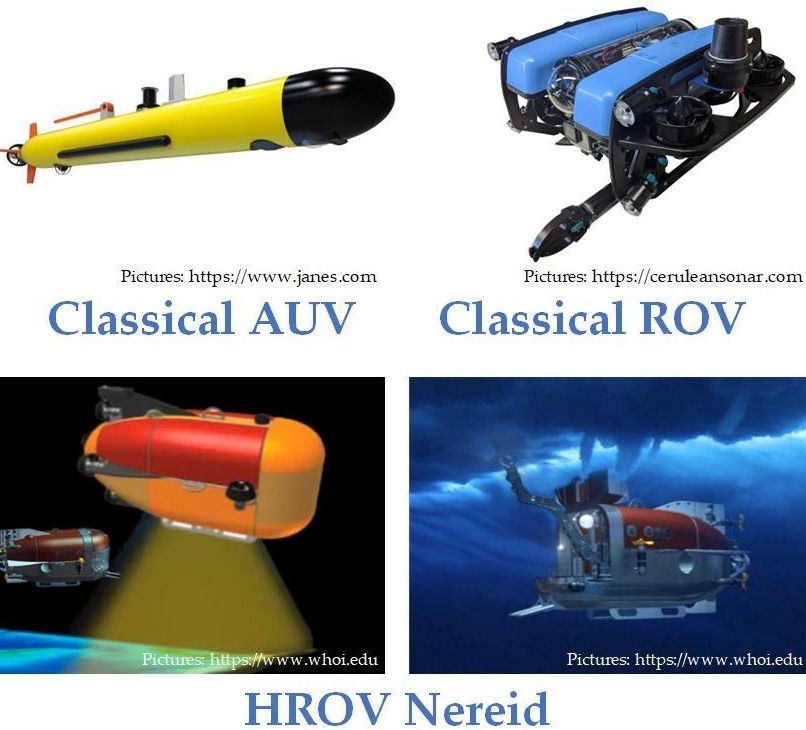Autonomous unmanned underwater vehicles. Unmanned underwater vehicles (UUVs) or underwater drones have become an attractive alternative for underwater observation and exploration since they are cheaper than manned underwater vehicles. These underwater vehicles or robotics can be divided into two categories: remotely operated underwater vehicles (ROVs) and autonomous underwater vehicles (AUVs)
- unmanned underwater vehicles (UUVs)
- simultaneous localization and mapping
Unmanned underwater vehicles (UUVs) or underwater drones have become an attractive alternative for underwater observation and exploration since they are cheaper than manned underwater vehicles. These underwater vehicles or robotics can be divided into two categories: remotely operated underwater vehicles (ROVs) and autonomous underwater vehicles (AUVs) [1-5]. A typical ROV is connected to a ship by a neutrally buoyant cable. These cables transmit command and control signals between the operator and the ROV, allowing remote navigation of the vehicle. Most ROVs are equipped with at least a video camera and lights. Additional equipment is commonly added to expand the vehicle's capabilities. These may include sonars, inertial navigation systems, magnetometers, etc., especially a robotic arm. Typical AUVs explores ocean without any attached cables. An AUV can conducts its survey mission without operator intervention. Researchers drop an AUV in the ocean pick it up at a pre-selected position. Today, AUVs can also carry equipment like video cameras, lights, sonars, etc., even robotic arms. The Underwater Robotics Market is evolving and designs are now following commercial requirements rather than being purely developmental. The boundaries between ROVs and AUVs are becoming more and more blurred. For example, hybrid AUV/ROV designs designed by the Woods Hole Oceanographic Institution (WHOI) has merged the functions and shapes of the two in order to complete complex underwater tasks more autonomously and freely.
Over the past decades, there have been abundant attempts to develop UUVs to meet the challenge of diversified applications in the oceans, though underwater environment is one of the most challenging scenes for robotics. With the development of artificial intelligence, photogrammetric computer vision, underwater sensors, battery and communication technologies in recent years, UUVs have played a very significant role in ocean-related monitoring and mapping tasks and become a research hotspot in ocean engineering, marine science and marine robotics. A common requirement for these missions is that the UUV needs to know its own position and attitude, in order to complete them. So, it is a crucial task for an autonomous UUV to build a map of the environment and to estimate its own pose within the map or under unknown environment while it is navigating. A technically referred to as simultaneously localization and mapping (SLAM) is nowadays a de facto standard for autonomous vehicles, not only in underwater environments, but also in ground and air environment. Besides, different from large-scale deep-sea scientific research, marine scientific research such as coastal coral reef protection, fishery management, and biological connectivity expects new UUVs to be miniaturized, intelligent, low-cost, and easy to maintain, so that they can be deployed in large quantities and long-term use. Therefore, how to realize the autonomous navigation and positioning of these new UUVs has become the primary problem to be solved. Today, most operators are still within range of acoustic telemetry systems to keep a close eye on their underwater robotic assets. This is not always possible. This is mainly because radio waves cannot penetrate water very far, so once a UUV dives, it loses its GPS signal.
 References:
References:
- Sahoo, A.; Dwivedy, S.; Robi, P. Advancements in the field of autonomous underwater vehicle. Ocean Engineering. 2019, 181, 145-160.
- Gilson, C. The Future of Optical Sensors Will Enhance Navigation. Ocean News & Technology Magazine. 2021, 12, 12-13.
- Petillot, Y.R.; Antonelli, G.; Casalino, G., et al. Underwater robots: From remotely operated vehicles to intervention-autonomous underwater vehicles. IEEE Robotics & Automation Magazine. 2019, 26, 94-101.
- He, Y.; Wang, D.; Ali, Z. A Review of Different Designs and Control Models of Remotely Operated Underwater Vehicle. Measurement and Control. 2020, 53, 1561-1570.
- Yoerger, D.; Govindarajan, A.; Howland, J.; Llopiz, J.; Wiebe, P.; Curran, M.; Fujii, J.; Gomez-Ibanez, D.; Katija, K.; Robison, B.; Hobson, B.; Risi, M.; Rock, S. A hybrid underwater robot for multidisciplinary investigation of the ocean twilight zone. Science Robotics. 2021, 6, 1901-1912.
This entry is adapted from the peer-reviewed paper 10.3390/rs14153794
